cruise control TOYOTA MATRIX 2013 E140 / 2.G Owners Manual
[x] Cancel search | Manufacturer: TOYOTA, Model Year: 2013, Model line: MATRIX, Model: TOYOTA MATRIX 2013 E140 / 2.GPages: 500, PDF Size: 14.83 MB
Page 3 of 500

1
2
3
4
5
6
7
3
2-3. Operating the lights and
wipers
Headlight switch .................. 138
Fog light switch ................... 141
Windshield wipers and
washer .............................. 143
Rear window wiper and
washer .............................. 146
2-4. Using other driving
systems
Cruise control ...................... 148
Driving assist systems ........ 152
2-5. Driving information
Cargo and luggage ............. 157
Vehicle load limits ............... 161
Winter driving tips ............... 162
Trailer towing
(1.8 L 4-cylinder
[2ZR-FE] engine) .............. 166
Trailer towing
(2.4 L 4-cylinder
[2AZ-FE] engine) .............. 167
Dinghy towing
(automatic transmission)... 181
Dinghy towing
(manual transmission) ...... 1823-1. Using the air conditioning
system and defogger
Air conditioning system ...... 186
Rear window and
outside rear view
mirror defoggers ............... 193
3-2. Using the audio system
Audio system types ............ 194
Using the radio ................... 203
Using the CD player ........... 207
Playing MP3 and WMA
discs ................................. 215
Operating an iPod .............. 225
Operating a USB
memory ............................ 234
Optimal use of the audio
system .............................. 242
Using the AUX port............. 246
Using the steering wheel
audio switches.................. 248
3-3. Using the Bluetooth
®
audio system
Bluetooth
® audio/phone ..... 251
Using the Bluetooth®
audio/phone ..................... 254
Operating a Bluetooth
®
enabled portable player.... 259
3Interior features
Page 15 of 500
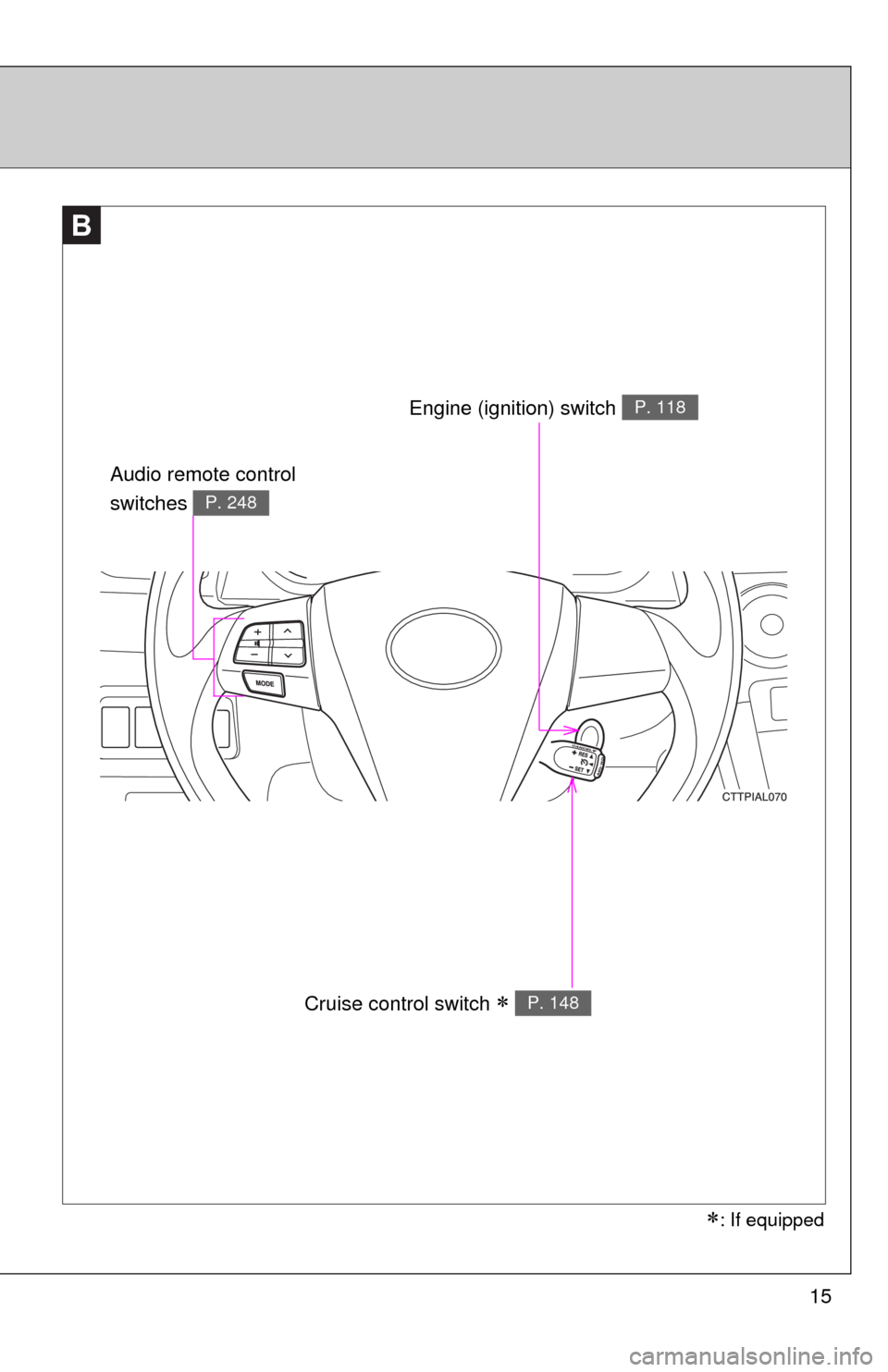
15
B
Cruise control switch P. 148
Engine (ignition) switch P. 118
Audio remote control
switches
P. 248
: If equipped
Page 19 of 500

19
Installation of a mobile two-way radio system
As the installation of a mobile two-way radio system in your vehicle may
affect electronic systems such as the multi-port fuel injection system/sequen-
tial multi-port fuel injection system, cruise control system, anti-lock brake
system, SRS airbag system or seat belt pretensioner system, be sure to
check with your Toyota dealer for precautionary measures or special instruc-
tions regarding installation.
Vehicle data recordings
Your Toyota is equipped with several sophisticated computers that will record
certain data, such as:
• Engine speed
• Accelerator status
• Brake status
• Vehicle speed
• Shift position (vehicles with an automatic transmission)
The recorded data varies according to the vehicle grade level and options
with which it is equipped. Furthermore, these computers do not record con-
versations, sounds or pictures.
●Data usage
Toyota may use the data recorded in these computers to diagnose malfunc-
tions, conduct research and development, and improve quality.
Toyota will not disclose the recorded data to a third party except:
• With the consent of the vehicle owner or with the consent of the lessee if
the vehicle is leased
• In response to an official request by the police, a court of law or a govern-
ment agency
• For use by Toyota in a lawsuit
• For research purposes where the data is not tied to a specific vehicle or
vehicle owner
Page 105 of 500
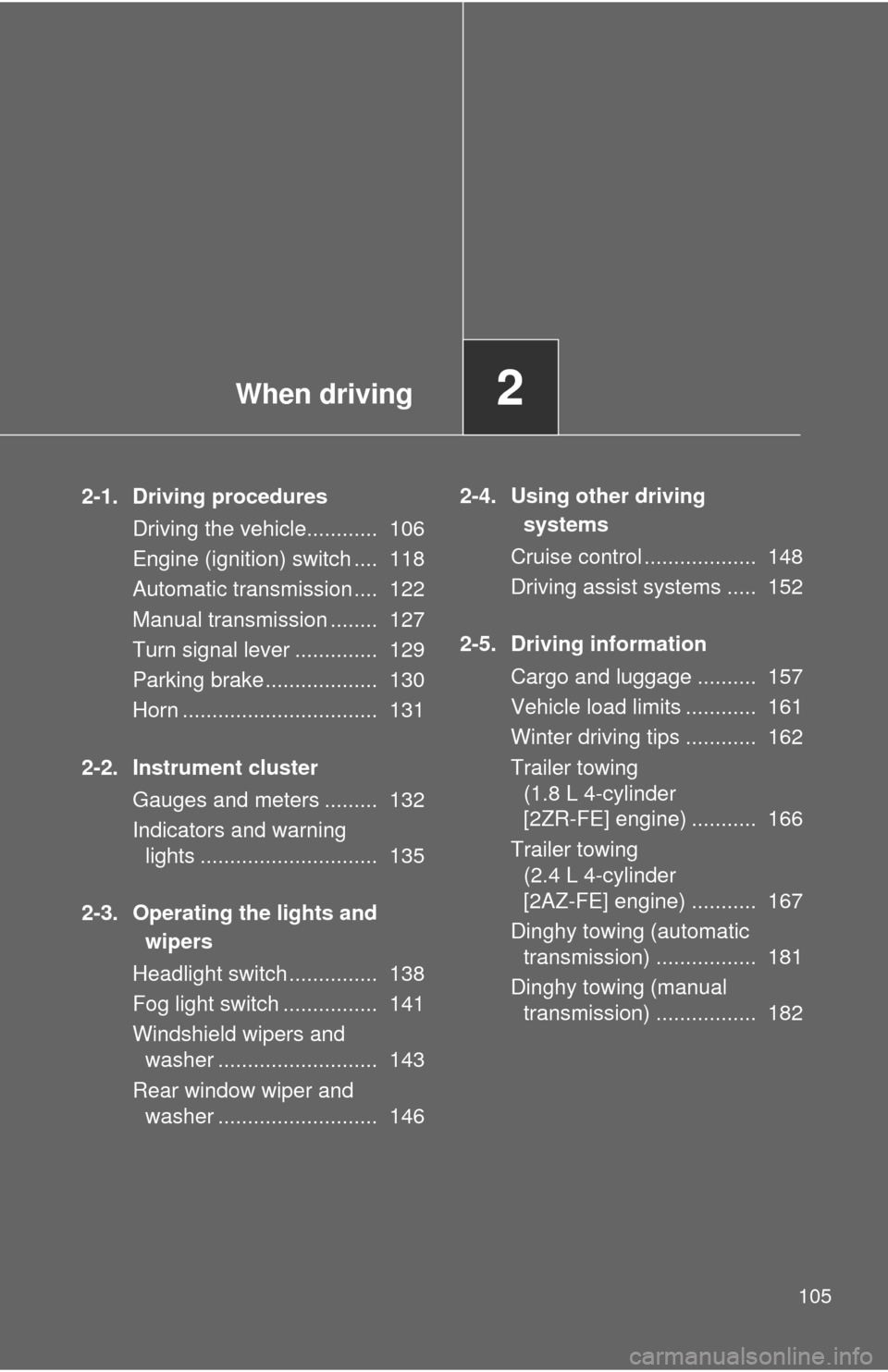
When driving2
105
2-1. Driving procedures
Driving the vehicle............ 106
Engine (ignition) switch .... 118
Automatic transmission .... 122
Manual transmission ........ 127
Turn signal lever .............. 129
Parking brake ................... 130
Horn ................................. 131
2-2. Instrument cluster
Gauges and meters ......... 132
Indicators and warning
lights .............................. 135
2-3. Operating the lights and
wipers
Headlight switch ............... 138
Fog light switch ................ 141
Windshield wipers and
washer ........................... 143
Rear window wiper and
washer ........................... 1462-4. Using other driving
systems
Cruise control ................... 148
Driving assist systems ..... 152
2-5. Driving information
Cargo and luggage .......... 157
Vehicle load limits ............ 161
Winter driving tips ............ 162
Trailer towing
(1.8 L 4-cylinder
[2ZR-FE] engine) ........... 166
Trailer towing
(2.4 L 4-cylinder
[2AZ-FE] engine) ........... 167
Dinghy towing (automatic
transmission) ................. 181
Dinghy towing (manual
transmission) ................. 182
Page 126 of 500

126 2-1. Driving procedures
■Downshifting restrictions warning buzzer (multi-mode type S mode)
To help ensure safety and driving performance, downshifting operation may
sometimes be restricted. In some circumstances, downshifting may not be
possible even when the shift lever is operated. (The warning buzzer will
sound twice.)
■When driving with the cruise control system (if equipped)
Standard type
Engine braking will not operate, even when downshifting to 3. (P. 148)
Multi-mode type
Engine braking will not operate in the S mode, even when downshifting to 4.
(P. 148)
■If the shift lever cannot be shifted from P
P. 423
■If the “S” indicator does not come on even after shifting the shift lever
to S (multi-mode type)
This may indicate a malfunction in the automatic transmission system. Have
the vehicle inspected by your Toyota dealer immediately.
(In this situation, the vehicle will operate as if the shift lever is in D.)
■AI-SHIFT
AI-SHIFT automatically selects the suitable gear according to driver perfor-
mance and driving conditions.
Standard type
AI-SHIFT automatically operates when the shift lever is in the D position.
Multi-mode type
AI-SHIFT automatically operates when the shift lever is in the D position.
(Shifting the shift lever to the S position cancels the function.)
Page 136 of 500
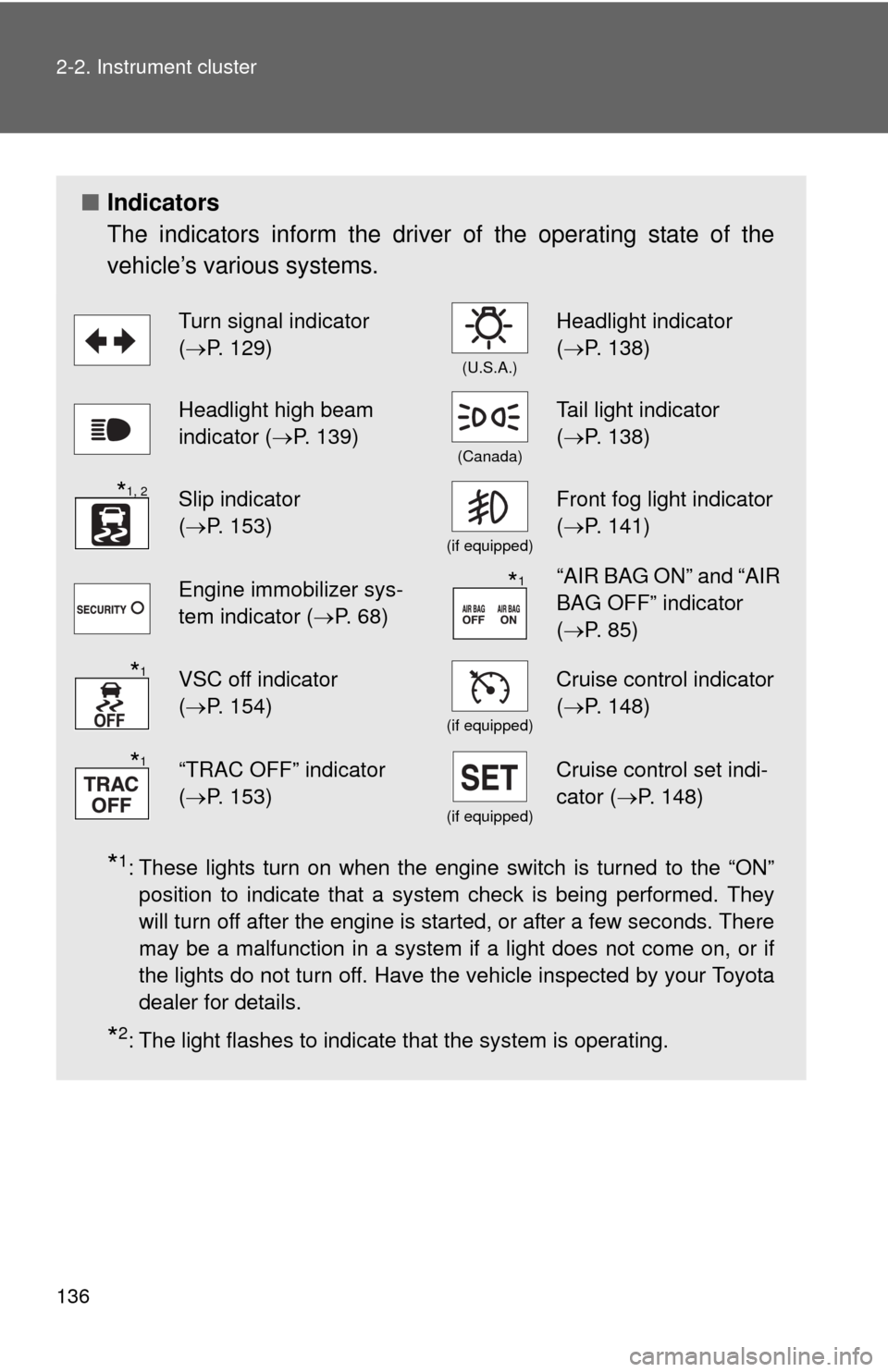
136 2-2. Instrument cluster
■Indicators
The indicators inform the driver of the operating state of the
vehicle’s various systems.
*1: These lights turn on when the engine switch is turned to the “ON”
position to indicate that a system check is being performed. They
will turn off after the engine is started, or after a few seconds. There
may be a malfunction in a system if a light does not come on, or if
the lights do not turn off. Have the vehicle inspected by your Toyota
dealer for details.
*2: The light flashes to indicate that the system is operating.
Turn signal indicator
(P. 129)
(U.S.A.)
Headlight indicator
(P. 138)
Headlight high beam
indicator (P. 139)
(Canada)
Tail light indicator
(P. 138)
Slip indicator
(P. 153)
(if equipped)
Front fog light indicator
(P. 141)
Engine immobilizer sys-
tem indicator (P. 68)“AIR BAG ON” and “AIR
BAG OFF” indicator
(P. 85)
VSC off indicator
(P. 154)
(if equipped)
Cruise control indicator
(P. 148)
“TRAC OFF” indicator
(P. 153)
(if equipped)
Cruise control set indi-
cator (P. 148)
*1, 2
*1
*1
*1
Page 148 of 500
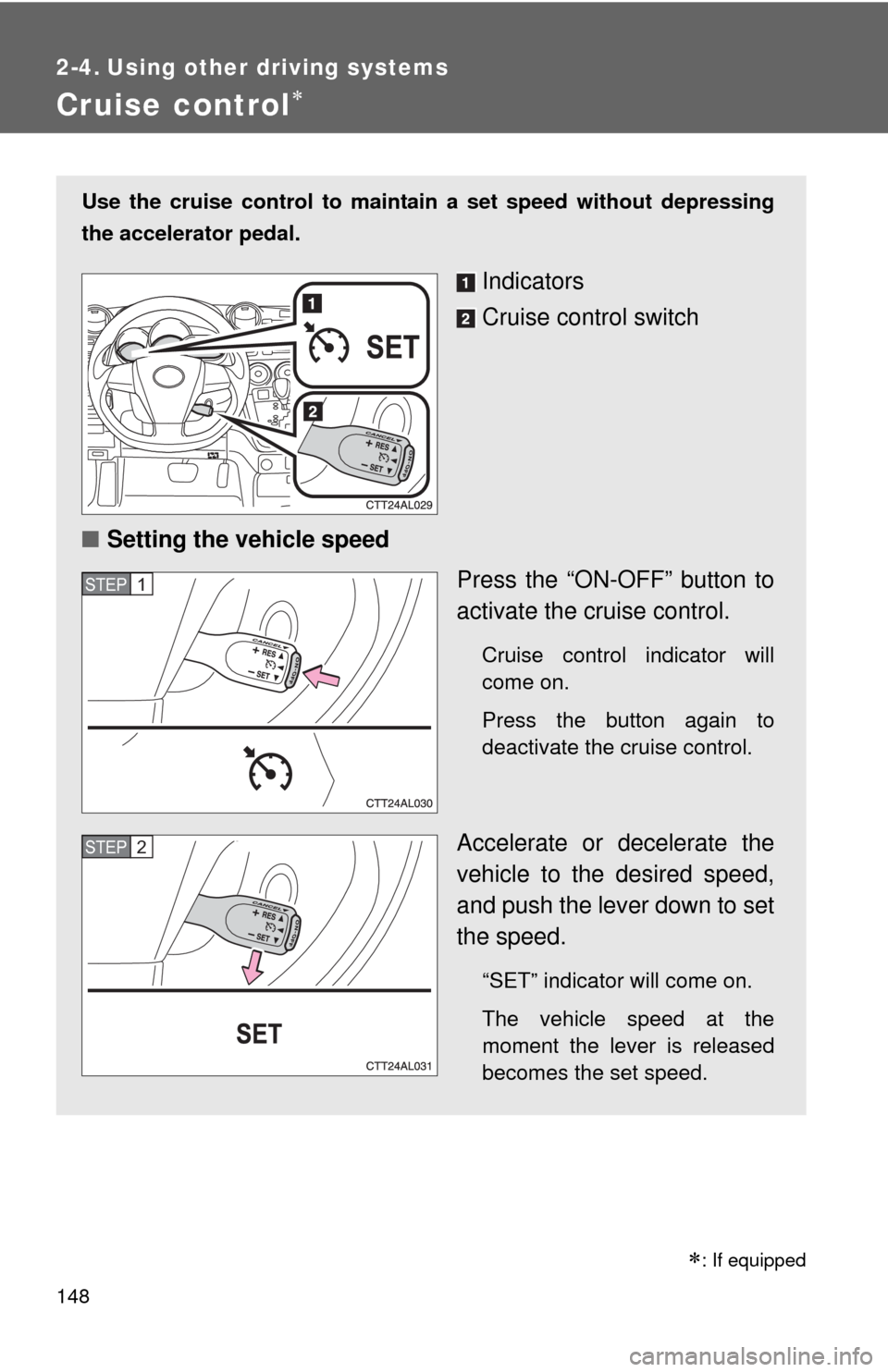
148
2-4. Using other driving systems
Cruise control
Use the cruise control to maintain a set speed without depressing
the accelerator pedal.
Indicators
Cruise control switch
■Setting the vehicle speed
Press the “ON-OFF” button to
activate the cruise control.
Cruise control indicator will
come on.
Press the button again to
deactivate the cruise control.
Accelerate or decelerate the
vehicle to the desired speed,
and push the lever down to set
the speed.
“SET” indicator will come on.
The vehicle speed at the
moment the lever is released
becomes the set speed.
STEP1
STEP2
�
: If equipped
Page 150 of 500
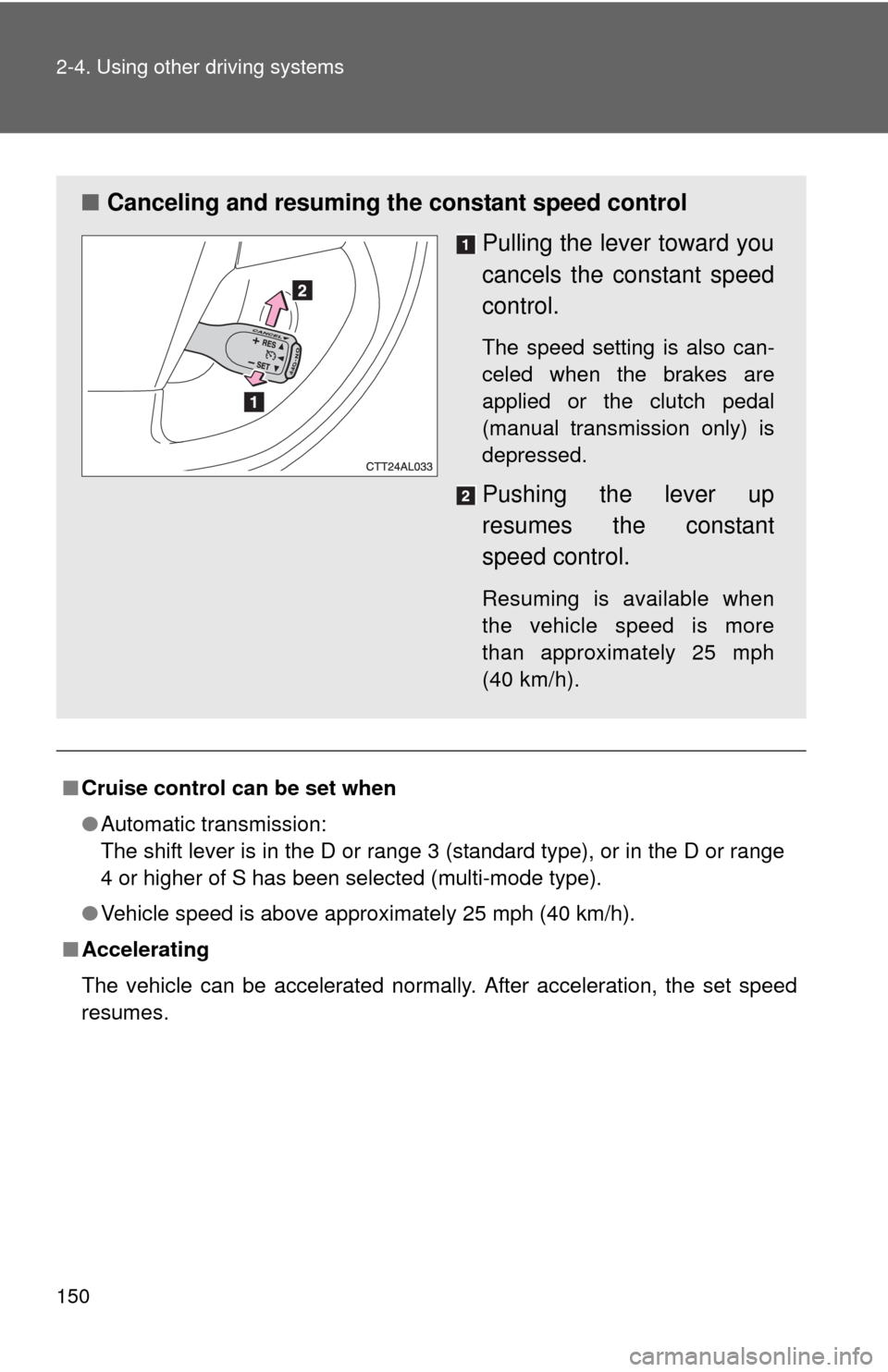
150 2-4. Using other driving systems
■Cruise control can be set when
●Automatic transmission:
The shift lever is in the D or range 3 (standard type), or in the D or range
4 or higher of S has been selected (multi-mode type).
●Vehicle speed is above approximately 25 mph (40 km/h).
■Accelerating
The vehicle can be accelerated normally. After acceleration, the set speed
resumes.
■Canceling and resuming the constant speed control
Pulling the lever toward you
cancels the constant speed
control.
The speed setting is also can-
celed when the brakes are
applied or the clutch pedal
(manual transmission only) is
depressed.
Pushing the lever up
resumes the constant
speed control.
Resuming is available when
the vehicle speed is more
than approximately 25 mph
(40 km/h).
Page 151 of 500
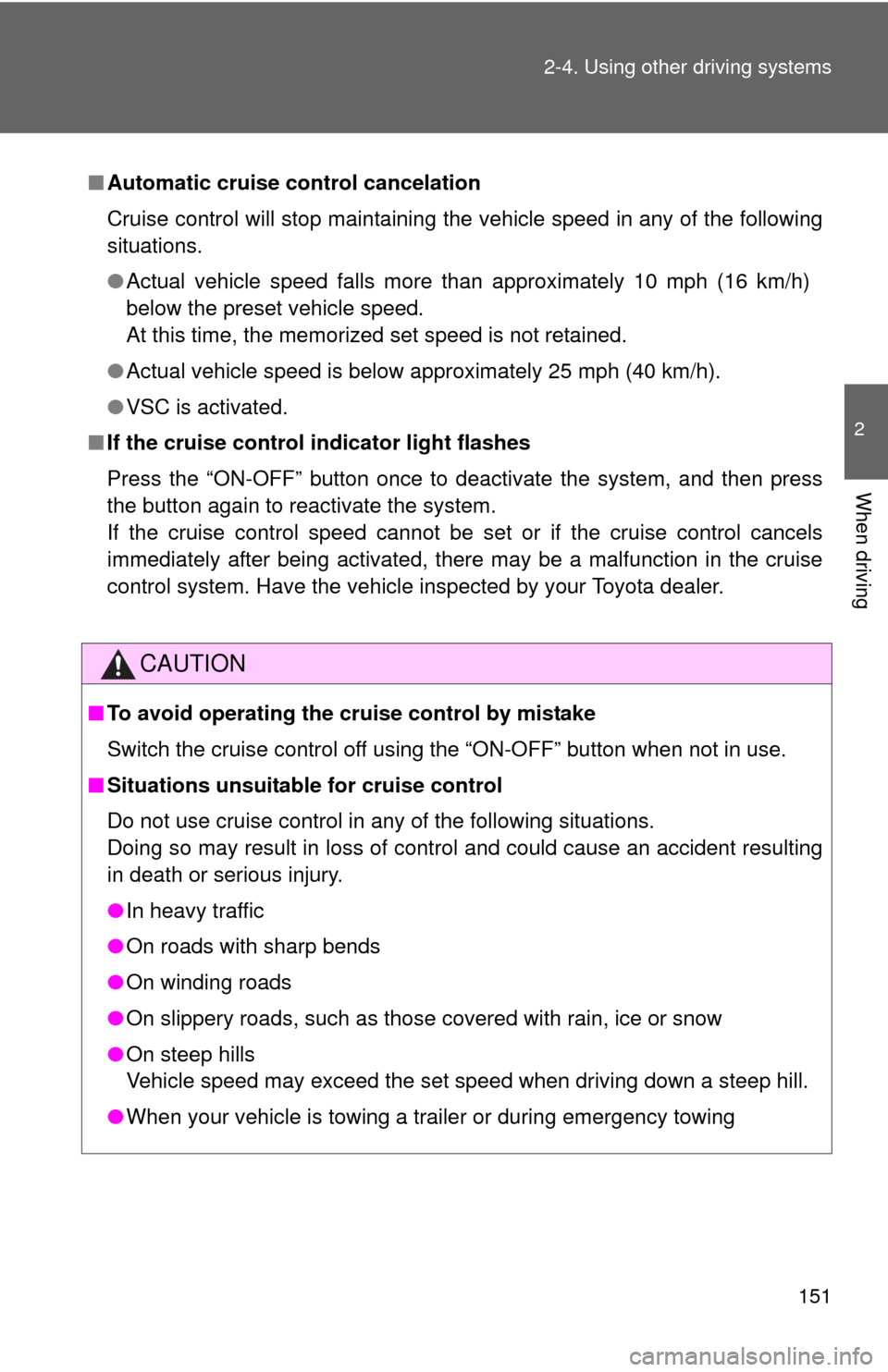
151 2-4. Using other driving systems
2
When driving
■Automatic cruise control cancelation
Cruise control will stop maintaining the vehicle speed in any of the following
situations.
●Actual vehicle speed falls more than approximately 10 mph (16 km/h)
below the preset vehicle speed.
At this time, the memorized set speed is not retained.
●Actual vehicle speed is below approximately 25 mph (40 km/h).
●VSC is activated.
■If the cruise control indicator light flashes
Press the “ON-OFF” button once to deactivate the system, and then press
the button again to reactivate the system.
If the cruise control speed cannot be set or if the cruise control cancels
immediately after being activated, there may be a malfunction in the cruise
control system. Have the vehicle inspected by your Toyota dealer.
CAUTION
■To avoid operating the cruise control by mistake
Switch the cruise control off using the “ON-OFF” button when not in use.
■Situations unsuitable for cruise control
Do not use cruise control in any of the following situations.
Doing so may result in loss of control and could cause an accident resulting
in death or serious injury.
●In heavy traffic
●On roads with sharp bends
●On winding roads
●On slippery roads, such as those covered with rain, ice or snow
●On steep hills
Vehicle speed may exceed the set speed when driving down a steep hill.
●When your vehicle is towing a trailer or during emergency towing
Page 179 of 500

179 2-5. Driving information
2
When driving
CAUTION
■To avoid accident or injury
●Do not exceed the TWR, unbraked TWR, GCWR, GVWR or GAWR.
●Adjust the tongue weight within the appropriate range. Place heavier loads
as close to the trailer axle as possible.
●Do not exceed 65 mph (104 km/h), the posted towing speed limit or the
speed limit for your trailer as set forth in your trailer owner’s manual,
whichever is lowest. Slow down sufficiently before making a turn, in cross
winds, on wet or slippery surface, etc. to help avoid an accident. If you
experience a vehicle-trailer instability from reducing a certain speed, slow
down and make sure you keep your vehicle speed under the speed of
which you experience the instability.
●Do not make jerky, abrupt or sharp turns.
●Do not apply the brakes suddenly as you may skid, resulting in jackknifing
and loss of vehicle control. This is especially true on wet or slippery sur-
faces.
●Do not exceed the trailer hitch assembly weight, gross vehicle weight,
gross axle weight and trailer tongue weight capacities.
●Do not use cruise control when towing.
●Slow down and downshift before descending steep or long downhill
grades. Do not make sudden downshifts while descending steep or long
downhill grades.
●Vehicle-trailer instability is more likely on steep long downhills. Before
descending steep or long downhill grades, slow down and downshift. Do
not make sudden downshifts when descending steep or long downhill
grades. Avoid holding the brake pedal down too long or applying the
brakes too frequently. This could cause the brakes to overheat and result
in reduced braking efficiency.
●Do not tow a trailer when the compact spare tire is installed on your vehi-
cle.